Sunday, 25 April 2010
Friday, 23 April 2010
Thriller Evaluation - (Friday, 23/04/2010)
1. In what ways does your media product use, develop or challenge forms and conventions of real media products?
With the opening sequence being an essential part of the film, it needs to express certain forms and conventions that establish the genre and narrative.
My opening sequence conforms to the conventions of a ‘real’ media product by:
- Introducing the antagonist, who is clearly identifiable as he is dressed in dark clothing, with his hood up and carrying a black bag, making him look menacing, and the stereotype of what a ‘bad guy’ may be

- Using opening credits
- Creating enigmas, for example the black plastic bag that the male character is carrying throughout the sequence. This is an enigma as the audience are not sure of the contents of the bag, and wish for this to be solved.
The enigma of the black bag is similar to the enigma tape in Lost Highway by David Lynch, in the same effect it creates by adding a sense of mystery and ambiguity.
- Drawing the audience in
- Using a soundtrack deliberately added to create an eerie atmosphere
These conventions are more commonly seen in thrillers, which is the genre I had chosen to work with.
My opening sequence challenges the conventions of a ‘real’ media product by:
- Filming in naturalistic lighting, and a lighter environment, which is not typical of a thriller
- Using handheld camera - such as in The Blair Witch Project, which also uses handheld camera, however they use it throughout the entire film, whereas I only used it for a short clip, which was added to create a sense of urgency and intensity.
- Using no dialogue
2. How does your media product represent particular social groups?
My film focuses on the younger generation, of teenagers around 13 – 18. I feel the opening does not have a specific social group to focus on; however I feel the film represents more middle-class citizens. I believe that my film represents young people in a stereotypical portrayal of being ‘thugs’ or potentially dangerous to people, which is implied by the dark clothing and black bag, suggesting the young male character is the antagonist. I also believe that my film represents the older generation stereotypically by using the ‘old woman’ character. She is portrayed as sitting down, whereas the young, male character is always walking, immediately making her seem inferior, and possibly vulnerable, which most old people are viewed as. Also, she is shrouded in a blanket, again making her seem vulnerable, however also mysterious. This image has been seen across a broad variety of films, but one genre that uses the old-lady characters most prominently is fairytales. Although these are not thrillers, or have any characteristics of thrillers, the older women are sometimes portrayed as haggard and evil.
http://www.heavenandearthdesigns.com/images/scott_gustafson/Little_Red_Riding_Hood1.jpg
This is demonstrated in such fairytales such as Little Red Riding Hood by the Brothers Grimm and Snow White & The Seven Dwarves. Though aimed at children, some of the same elements of the mysterious, and possibly evil, old lady are in these fairytales.
I decided to use this element of the 'evil old hag' from fairytales in order to construct my piece, even though fairytales were not the specified genre. However, I do feel that the element of fairytale works well, as it is well known and easy to portray.
3. What kind of media institution might distribute your media product and why?
EM media is the type of institution that I would expect to aid the production of my film by providing sets, casts and funding, however they are not a distribution company. A distributor who may work in conjunction with our film may be Optimum, which works with the films EM media helps. I believe these would be a suitable distribution company as they distribute lower budget films, such as This Is England, which is not a thriller; however has a darker side, much like my film. I believe my film would fit into the ‘alternative’ category, as I believe it would receive a better reception from a ‘darker’ audience, who enjoy dark films, such as The Orphanage or Eden Lake.
However, product could also be distributed online, like some unconventional distributors do. This could use social networking sites popular with a young audience, such as Myspace and Facebook, to distribute my film and therefore promote it, targeting the audience. This would be useful as it would be available to a wide audience, but also attract the specific audience.
Also, my product could be marketed online as an efficient method of marketing. This would be similar to the way Le Donk & Scor-zay-zee (Shane Meadows, 2009) was marketed online, as they released the first 10 minutes of their film online in order to encourage viewers to watch and take interest.
http://www.shanemeadows.co.uk/
(Le Donk & Scor-zay-zee trailer)
4. Who would be the audience for your media product?
The initial targeted audience for our thriller was teenagers, both male and female, ranging from the age of around 16 - 36 (young audience), depending on what age certificate the ‘finished’ film would be. However, I feel my film may appeal to men more, as the thriller genre is often more associated with men, as it is often scary, therefore if you watch them you may be deemed ‘brave’, which is often associated with masculinity. Also, the main character in this film is male, and young, which represents males in a more positive light, therefore men may relate to them more. In contrast, the female character is perceived as old, therefore possibly representing women in a more negative light.
My film would appeal to both male and female adolescents with an unusual taste in films, who enjoy the thriller genre, as i feel it has a niche audience, who would enjoy alternative films, therefore targeting a specific group of people.
5. How did you attract/address your audience?
In order to obtain information about what our audience preferred in a thriller, we gave ten teenagers, aged between 14 and 17, a questionnaire asking them a variety of questions about their taste in thrillers.
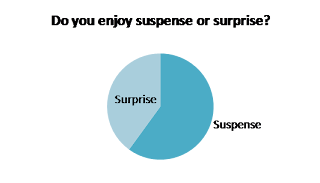
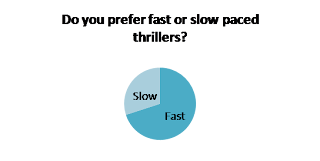
From this, I found a number of things, such as: they would only prefer a few key characters, for it to have suspense and for the thriller to be fast paced. Although I could work with most of these requests, unfortunately I could not meet the needs of all of these requests. However, I feel that dealing with the essential requests therefore attracted the audience sufficiently.
I kept to the targeted age bracket using a variety of techniques. One of these techniques being by using camera techniques more commonly used in modern thrillers, such as handheld camera, which is normally aimed at teenagers.
Also, the main character is clearly a teenager or young adult. This would also appeal to a teenage audience, more so than an older audience, because they would be able to relate with the main character and possibly understand his actions or intentions.
Also, I filmed in a suburban setting, which appeals to my audience, and also filmed what is perceived as middle class citizens and houses. This targets aspirational people, and also appeals to the target audiences ideal.
If i had a bigger budget, I would attract my audience by using posters to promote my film. This would appeal more to teenagers, particularly advertising on the internet, or on a TV station, such as E4, which is popular with younger people.
However, I could use viral marketing for advertising, which is virtually free, which would be useful for a low budget film such as mine.
6. What have you learnt about technologies from the process of constructing this product?
I have learnt that technologies can be unreliable and can disappoint on occasions. For instance, some of our capturing would not work on the computer, yet we did not make any mistakes. Therefore, an error had occurred that we could not fix as we did not know where we went wrong. Also, the sound quality on the camera was not very good when filming in windy conditions, therefore the filming sounded grainy and could not be used in the final product.
However, we overcame these problems by, for instance, re-shooting scenes which were not suitable for use, and working our way around problems such as a grainy ambient sound by muting the soundtrack and playing a piece of incidental music over the top of it.
If was set this task again, I would do a number of things differently for different reasons. Firstly, I would use a different camera, and if a bigger budget was available, I would use a more professional camera. This would give a better picture and sound quality, making the overall product better in my opinion. Also, I would use a better tripod and other equipment, such as lighting, as this would enhance the product; again giving a more clear and professional look overall. However, as my film looks low-budget, it can clearly be established as a film EM Media may help with funding for and Optimum may distribute.
7. Looking back at your preliminary task, what do you feel you have learnt in the progression from it to the full product?
I feel that I have learnt the true importance of varying different shots, and making sure that there is more than one take to each scene, as sometimes the shots do not look how you would expect them. Also, I have learnt how to edit more efficiently and professionally using Adobe Premier Pro CS4 compared to my preliminary task, and how to use effects and transitions to enhance the filming.
I have also learnt how to identify continuity errors, therefore making the filming look more professional and avoid losing marks for small errors.
For instance, in my preliminary task I broke the 180 degree rule:
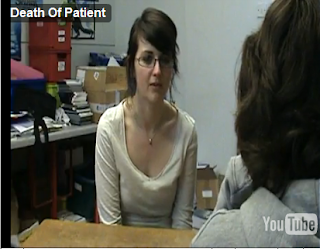
In this shot, it can clearly be seen that the filming is over the male character’s LEFT shoulder, looking at the female character.
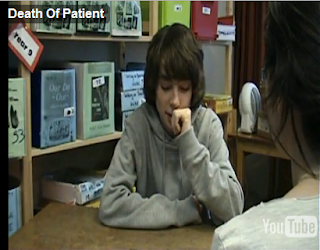
However, in this shot, the male character is being filmed over the female character’s LEFT shoulder also, where as it should have been filmed over the RIGHT shoulder.
Although this is only a small continuity error that may be unrecognisable, it does not look as professional, and may lose marks in the actual filming.
Also, I have learnt how to identify what effects and transitions are appropriate to use for the genre of film i created. For instance, the ‘centre split’ transition would not be appropriate, as it does not look professional.
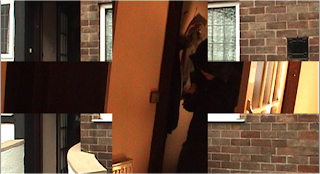
Overall, I have learnt how to successfully film and produce a short film using software that i had previously not worked with. I also learnt how to manage my time efficiently in order to get all editing, blogging and filming done in an achievable space of time.
I believe my skills have progressed in many ways, such as time management, group & communication skills and also editing skills.
With the opening sequence being an essential part of the film, it needs to express certain forms and conventions that establish the genre and narrative.
My opening sequence conforms to the conventions of a ‘real’ media product by:
- Introducing the antagonist, who is clearly identifiable as he is dressed in dark clothing, with his hood up and carrying a black bag, making him look menacing, and the stereotype of what a ‘bad guy’ may be

- Using opening credits
- Creating enigmas, for example the black plastic bag that the male character is carrying throughout the sequence. This is an enigma as the audience are not sure of the contents of the bag, and wish for this to be solved.
The enigma of the black bag is similar to the enigma tape in Lost Highway by David Lynch, in the same effect it creates by adding a sense of mystery and ambiguity.
- Drawing the audience in
- Using a soundtrack deliberately added to create an eerie atmosphere
These conventions are more commonly seen in thrillers, which is the genre I had chosen to work with.
My opening sequence challenges the conventions of a ‘real’ media product by:
- Filming in naturalistic lighting, and a lighter environment, which is not typical of a thriller
- Using handheld camera - such as in The Blair Witch Project, which also uses handheld camera, however they use it throughout the entire film, whereas I only used it for a short clip, which was added to create a sense of urgency and intensity.
- Using no dialogue
2. How does your media product represent particular social groups?
My film focuses on the younger generation, of teenagers around 13 – 18. I feel the opening does not have a specific social group to focus on; however I feel the film represents more middle-class citizens. I believe that my film represents young people in a stereotypical portrayal of being ‘thugs’ or potentially dangerous to people, which is implied by the dark clothing and black bag, suggesting the young male character is the antagonist. I also believe that my film represents the older generation stereotypically by using the ‘old woman’ character. She is portrayed as sitting down, whereas the young, male character is always walking, immediately making her seem inferior, and possibly vulnerable, which most old people are viewed as. Also, she is shrouded in a blanket, again making her seem vulnerable, however also mysterious. This image has been seen across a broad variety of films, but one genre that uses the old-lady characters most prominently is fairytales. Although these are not thrillers, or have any characteristics of thrillers, the older women are sometimes portrayed as haggard and evil.

http://www.heavenandearthdesigns.com/images/scott_gustafson/Little_Red_Riding_Hood1.jpg
This is demonstrated in such fairytales such as Little Red Riding Hood by the Brothers Grimm and Snow White & The Seven Dwarves. Though aimed at children, some of the same elements of the mysterious, and possibly evil, old lady are in these fairytales.
I decided to use this element of the 'evil old hag' from fairytales in order to construct my piece, even though fairytales were not the specified genre. However, I do feel that the element of fairytale works well, as it is well known and easy to portray.
3. What kind of media institution might distribute your media product and why?
EM media is the type of institution that I would expect to aid the production of my film by providing sets, casts and funding, however they are not a distribution company. A distributor who may work in conjunction with our film may be Optimum, which works with the films EM media helps. I believe these would be a suitable distribution company as they distribute lower budget films, such as This Is England, which is not a thriller; however has a darker side, much like my film. I believe my film would fit into the ‘alternative’ category, as I believe it would receive a better reception from a ‘darker’ audience, who enjoy dark films, such as The Orphanage or Eden Lake.


However, product could also be distributed online, like some unconventional distributors do. This could use social networking sites popular with a young audience, such as Myspace and Facebook, to distribute my film and therefore promote it, targeting the audience. This would be useful as it would be available to a wide audience, but also attract the specific audience.
Also, my product could be marketed online as an efficient method of marketing. This would be similar to the way Le Donk & Scor-zay-zee (Shane Meadows, 2009) was marketed online, as they released the first 10 minutes of their film online in order to encourage viewers to watch and take interest.
http://www.shanemeadows.co.uk/
(Le Donk & Scor-zay-zee trailer)
This is similar to Avatar (James Cameron, 2009) which was also promoted on the popular video sharing website, common with the 'younger' generation, Youtube, in order to encourage viewers.
4. Who would be the audience for your media product?
The initial targeted audience for our thriller was teenagers, both male and female, ranging from the age of around 16 - 36 (young audience), depending on what age certificate the ‘finished’ film would be. However, I feel my film may appeal to men more, as the thriller genre is often more associated with men, as it is often scary, therefore if you watch them you may be deemed ‘brave’, which is often associated with masculinity. Also, the main character in this film is male, and young, which represents males in a more positive light, therefore men may relate to them more. In contrast, the female character is perceived as old, therefore possibly representing women in a more negative light.
My film would appeal to both male and female adolescents with an unusual taste in films, who enjoy the thriller genre, as i feel it has a niche audience, who would enjoy alternative films, therefore targeting a specific group of people.
5. How did you attract/address your audience?
In order to obtain information about what our audience preferred in a thriller, we gave ten teenagers, aged between 14 and 17, a questionnaire asking them a variety of questions about their taste in thrillers.



From this, I found a number of things, such as: they would only prefer a few key characters, for it to have suspense and for the thriller to be fast paced. Although I could work with most of these requests, unfortunately I could not meet the needs of all of these requests. However, I feel that dealing with the essential requests therefore attracted the audience sufficiently.
I kept to the targeted age bracket using a variety of techniques. One of these techniques being by using camera techniques more commonly used in modern thrillers, such as handheld camera, which is normally aimed at teenagers.
Also, the main character is clearly a teenager or young adult. This would also appeal to a teenage audience, more so than an older audience, because they would be able to relate with the main character and possibly understand his actions or intentions.
Also, I filmed in a suburban setting, which appeals to my audience, and also filmed what is perceived as middle class citizens and houses. This targets aspirational people, and also appeals to the target audiences ideal.
If i had a bigger budget, I would attract my audience by using posters to promote my film. This would appeal more to teenagers, particularly advertising on the internet, or on a TV station, such as E4, which is popular with younger people.
However, I could use viral marketing for advertising, which is virtually free, which would be useful for a low budget film such as mine.
6. What have you learnt about technologies from the process of constructing this product?
I have learnt that technologies can be unreliable and can disappoint on occasions. For instance, some of our capturing would not work on the computer, yet we did not make any mistakes. Therefore, an error had occurred that we could not fix as we did not know where we went wrong. Also, the sound quality on the camera was not very good when filming in windy conditions, therefore the filming sounded grainy and could not be used in the final product.
However, we overcame these problems by, for instance, re-shooting scenes which were not suitable for use, and working our way around problems such as a grainy ambient sound by muting the soundtrack and playing a piece of incidental music over the top of it.
If was set this task again, I would do a number of things differently for different reasons. Firstly, I would use a different camera, and if a bigger budget was available, I would use a more professional camera. This would give a better picture and sound quality, making the overall product better in my opinion. Also, I would use a better tripod and other equipment, such as lighting, as this would enhance the product; again giving a more clear and professional look overall. However, as my film looks low-budget, it can clearly be established as a film EM Media may help with funding for and Optimum may distribute.
7. Looking back at your preliminary task, what do you feel you have learnt in the progression from it to the full product?
I feel that I have learnt the true importance of varying different shots, and making sure that there is more than one take to each scene, as sometimes the shots do not look how you would expect them. Also, I have learnt how to edit more efficiently and professionally using Adobe Premier Pro CS4 compared to my preliminary task, and how to use effects and transitions to enhance the filming.
I have also learnt how to identify continuity errors, therefore making the filming look more professional and avoid losing marks for small errors.
For instance, in my preliminary task I broke the 180 degree rule:

In this shot, it can clearly be seen that the filming is over the male character’s LEFT shoulder, looking at the female character.

However, in this shot, the male character is being filmed over the female character’s LEFT shoulder also, where as it should have been filmed over the RIGHT shoulder.
Although this is only a small continuity error that may be unrecognisable, it does not look as professional, and may lose marks in the actual filming.
Also, I have learnt how to identify what effects and transitions are appropriate to use for the genre of film i created. For instance, the ‘centre split’ transition would not be appropriate, as it does not look professional.

Overall, I have learnt how to successfully film and produce a short film using software that i had previously not worked with. I also learnt how to manage my time efficiently in order to get all editing, blogging and filming done in an achievable space of time.
I believe my skills have progressed in many ways, such as time management, group & communication skills and also editing skills.
Friday, 16 April 2010
Thriller Re-Editing - (16/04/2010)
Today, Shaun, Alex and I captured our newly filmed scenes and decided which ones were the best and most appropriate to use. We then put these into our sequence, deleting the old scenes, and edited them accordingly to ensure the film flowed naturally.
However, due to the draft evaluation being due in, we could not work on the editing for a great deal of time, and therefore had to concentrate on our evaluations.
Also, we noticed a continuity error where the hue of the picture alters slightly with a blue-ish tinge from having a more natural colouration, and also the male actor is wearing different coloured jeans. Although these errors were noticed prior to editing, we unfortunately could not change this.
However, due to the draft evaluation being due in, we could not work on the editing for a great deal of time, and therefore had to concentrate on our evaluations.
Also, we noticed a continuity error where the hue of the picture alters slightly with a blue-ish tinge from having a more natural colouration, and also the male actor is wearing different coloured jeans. Although these errors were noticed prior to editing, we unfortunately could not change this.
Thriller Evaluation [Draft] - (Friday, 16/04/2010)
1. In what ways does your media product use, develop or challenge forms and conventions of real media products?
With the opening sequence being an essential part of the film, it needs to express certain forms and conventions that establish the genre and narrative.
My opening sequence conforms to the conventions of a ‘real’ media product by:
- Introducing the antagonist, who is clearly identifiable as he is dressed in dark clothing, with his hood up and carrying a black bag, making him look menacing, and the stereotype of what a ‘bad guy’ may be

- Using opening credits
- Creating enigmas, for example the black plastic bag that the male character is carrying throughout the sequence. This is an enigma as the audience are not sure of the contents of the bag, and wish for this to be solved.
- Drawing the audience in
- Using a soundtrack deliberately added to create an eerie atmosphere
These conventions are more commonly seen in thrillers, which is the genre i had chosen to work with.
My opening sequence challenges the conventions of a ‘real’ media product by:
- Filming in naturalistic lighting, and a lighter environment, which is not typical of a thriller
- Using handheld camera
- Using no dialogue
2. How does your media product represent particular social groups?
My film focuses on the younger generation, of teenagers around 13 – 18. I feel the opening does not have a specific social group to focus on; however i feel the film represents more middle-class citizens. I cast Shaun Cutts as the main antagonist as he was readily available and he
3. What kind of media institution might distribute your media product and why?
EM media is the type of institution that i would expect to aid the production of my film by providing sets, casts and funding, however they are not a distribution company. A distributer who may work in conjunction with our film may be Optimum, which works with the film EM media helps. I believe these would be a suitable distribution company as they distribute lower budget films, such as This Is England, which is not a thriller; however has a darker side, much like my film. This darker side is present in the form of the enigmas of the perceived old woman and the black bag.
4. Who would be the audience for your media product?
The initial targeted audience for our thriller was teenagers, both male and female, ranging from the age of around 15 to 18, depending on what age certificate the ‘finished’ film would be. However, i feel my film may appeal to men more, as the thriller genre is often more associated with men, as it is often scary, therefore if you watch them you may be deemed ‘brave’, which is often associated with masculinity. Also, the main character in this film is male, and young, which represents males in a more positive light, therefore men may relate to them more. In contrast, the female character is perceived as old, therefore possibly representing women in a more negative light.
My film would appeal to both male and female adolescents with an obscure taste in films, who enjoy the thriller genre, as i feel it has a niche audience, therefore targeting a specific group of people.
5. How did you attract/address your audience?
We kept to our targeted age bracket using a variety of techniques. One of these techniques being by using camera techniques more commonly used in modern thrillers, which are normally aged at teenagers. Also, the main character is clearly a teenager or young adult. This would also appeal to a teenage audience, more so than an older audience, because they would be able to relate with the main character, and possible understand his actions or intentions.
6. What have you learnt about technologies from the process of constructing this product?
I have learnt that technologies can be unreliable and can disappoint on occasions. For instance, some of our capturing would not work on the computer, yet we did not make any mistakes. Therefore, an error had occurred that we could not fix as we did not know where we went wrong. Also, the sound quality on the camera was not very good when filming in windy conditions, therefore the filming sounded grainy and could not be used in the final product.
7. Looking back at your preliminary task, what do you feel you have learnt in the progression from it to the full product?
I feel that I have learnt the true importance of varying different shots, and making sure that there is more than one take to each scene, as sometimes the shots do not look how you would expect them. Also, i have learnt how to edit more efficiently and professionally using Adobe Premier Pro CS4 compared to my preliminary task, and how to use effects and transitions to enhance the filming.
I have also learnt how to identify continuity errors, therefore making the filming look more professional and avoid losing marks for small errors.
For instance, in my preliminary task i broke the 180 degree rule:

In this shot, it can clearly be seen that the filming is over the male character’s LEFT shoulder, looking at the female character.

However, in this shot, the male character is being filmed over the female character’s LEFT shoulder also, where as it should have been filmed over the RIGHT shoulder.
Although this is only a small continuity error that may be unrecognisable, it does not look as professional, and may lose marks in the actual filming.
I have also learnt how to use effects, shots and transitions appropriate to the genre of the film. For example:
With the opening sequence being an essential part of the film, it needs to express certain forms and conventions that establish the genre and narrative.
My opening sequence conforms to the conventions of a ‘real’ media product by:
- Introducing the antagonist, who is clearly identifiable as he is dressed in dark clothing, with his hood up and carrying a black bag, making him look menacing, and the stereotype of what a ‘bad guy’ may be

- Using opening credits
- Creating enigmas, for example the black plastic bag that the male character is carrying throughout the sequence. This is an enigma as the audience are not sure of the contents of the bag, and wish for this to be solved.
- Drawing the audience in
- Using a soundtrack deliberately added to create an eerie atmosphere
These conventions are more commonly seen in thrillers, which is the genre i had chosen to work with.
My opening sequence challenges the conventions of a ‘real’ media product by:
- Filming in naturalistic lighting, and a lighter environment, which is not typical of a thriller
- Using handheld camera
- Using no dialogue
2. How does your media product represent particular social groups?
My film focuses on the younger generation, of teenagers around 13 – 18. I feel the opening does not have a specific social group to focus on; however i feel the film represents more middle-class citizens. I cast Shaun Cutts as the main antagonist as he was readily available and he
3. What kind of media institution might distribute your media product and why?
EM media is the type of institution that i would expect to aid the production of my film by providing sets, casts and funding, however they are not a distribution company. A distributer who may work in conjunction with our film may be Optimum, which works with the film EM media helps. I believe these would be a suitable distribution company as they distribute lower budget films, such as This Is England, which is not a thriller; however has a darker side, much like my film. This darker side is present in the form of the enigmas of the perceived old woman and the black bag.
4. Who would be the audience for your media product?
The initial targeted audience for our thriller was teenagers, both male and female, ranging from the age of around 15 to 18, depending on what age certificate the ‘finished’ film would be. However, i feel my film may appeal to men more, as the thriller genre is often more associated with men, as it is often scary, therefore if you watch them you may be deemed ‘brave’, which is often associated with masculinity. Also, the main character in this film is male, and young, which represents males in a more positive light, therefore men may relate to them more. In contrast, the female character is perceived as old, therefore possibly representing women in a more negative light.
My film would appeal to both male and female adolescents with an obscure taste in films, who enjoy the thriller genre, as i feel it has a niche audience, therefore targeting a specific group of people.
5. How did you attract/address your audience?
We kept to our targeted age bracket using a variety of techniques. One of these techniques being by using camera techniques more commonly used in modern thrillers, which are normally aged at teenagers. Also, the main character is clearly a teenager or young adult. This would also appeal to a teenage audience, more so than an older audience, because they would be able to relate with the main character, and possible understand his actions or intentions.
6. What have you learnt about technologies from the process of constructing this product?
I have learnt that technologies can be unreliable and can disappoint on occasions. For instance, some of our capturing would not work on the computer, yet we did not make any mistakes. Therefore, an error had occurred that we could not fix as we did not know where we went wrong. Also, the sound quality on the camera was not very good when filming in windy conditions, therefore the filming sounded grainy and could not be used in the final product.
7. Looking back at your preliminary task, what do you feel you have learnt in the progression from it to the full product?
I feel that I have learnt the true importance of varying different shots, and making sure that there is more than one take to each scene, as sometimes the shots do not look how you would expect them. Also, i have learnt how to edit more efficiently and professionally using Adobe Premier Pro CS4 compared to my preliminary task, and how to use effects and transitions to enhance the filming.
I have also learnt how to identify continuity errors, therefore making the filming look more professional and avoid losing marks for small errors.
For instance, in my preliminary task i broke the 180 degree rule:

In this shot, it can clearly be seen that the filming is over the male character’s LEFT shoulder, looking at the female character.

However, in this shot, the male character is being filmed over the female character’s LEFT shoulder also, where as it should have been filmed over the RIGHT shoulder.
Although this is only a small continuity error that may be unrecognisable, it does not look as professional, and may lose marks in the actual filming.
I have also learnt how to use effects, shots and transitions appropriate to the genre of the film. For example:
Thursday, 15 April 2010
Thriller Refilming - Wednesday, (14/04/2010)
Today, Shaun, Alex and I refilmed the parts of our sequence that we decided were not sufficient.
Alex filmed the pan shot up the driveway to the door, as the lost shot of this was slanted when we filmed it orginally. We then used handheld camera (which Alex filmed) to add a sense of mystery and ambiguity to our sequence, which was recommended by Mr. Mitchell.
Finally, I filmed a close up of Shaun's hand on the door handle, which then ended with a zoom in. This was to enable continuity from the handheld camera shot to the final shot, which is an over the shoulder shot of Shaun's character entering the room and throwing down the bag. This is different to the original ending, however we felt it was more suitable and was easy to achieve with the resources available.
The last thing left for us to do is to re edit the ending of our sequence, choose more appropriate music and make sure the entire sequence flows well.
Alex filmed the pan shot up the driveway to the door, as the lost shot of this was slanted when we filmed it orginally. We then used handheld camera (which Alex filmed) to add a sense of mystery and ambiguity to our sequence, which was recommended by Mr. Mitchell.
Finally, I filmed a close up of Shaun's hand on the door handle, which then ended with a zoom in. This was to enable continuity from the handheld camera shot to the final shot, which is an over the shoulder shot of Shaun's character entering the room and throwing down the bag. This is different to the original ending, however we felt it was more suitable and was easy to achieve with the resources available.
The last thing left for us to do is to re edit the ending of our sequence, choose more appropriate music and make sure the entire sequence flows well.
Monday, 12 April 2010
Thriller Evaluation - (Monday, 12/04/2010)
Today, the class looked at how to evaluate our pieces, and established that the deadline for the draft of the evaluation is to be in for Friday, 16/04/2010.
We were given a sheet and example answer to inspire us and to aid us in composing our evalutation.
We were given a sheet and example answer to inspire us and to aid us in composing our evalutation.
Subscribe to:
Comments (Atom)